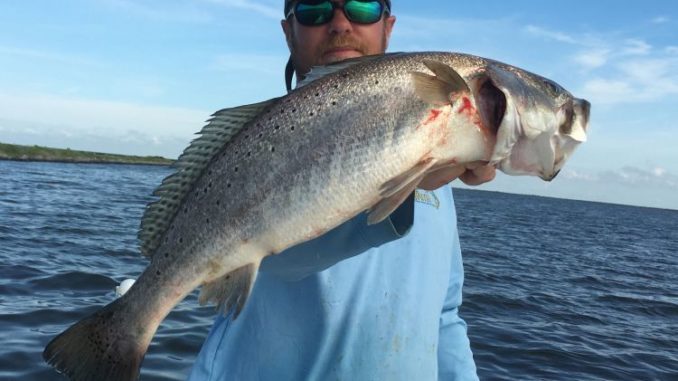
Slight variation in leader length could mean big difference in speck quality, guide says
August typically features some of the hottest temperatures of Louisiana’s long summer, and for Shell Beach guide Capt. Jakamo Laboureur that means it’s time to get an early start to beat the heat to catch speckled trout.
“August is that month where it’s hot. There’s no wind, the seas are calm and it can get pretty miserable. The main deal this month, especially in shallower areas under 10 feet, is the morning bite will become really important,” said Laboureur, with Jakamo South Fishing Charters. “Even redfish in the interior marshes — lots of time the water temperature will shoot up to the mid- to high-90s, so that can even make the redfish a little spooky.
“They’re going to want to be where there’s at least some amount of water with a reasonable temperature, hopefully in the mid-80s.”
For speckled trout, Laboureur said it would be wise to focus your efforts either early or late in the day.
“Late afternoon or early morning is what you want to do,” he said. “The midday bite gets less and less. It’s not that it’s impossible, but you definitely are going to want to at least get off the shoreline and fish deeper-water reefs.”
Laboureur tackles the MRGO rocks with live shrimp from Campo’s, and typically starts 2 or 3 feet under a popping cork. As always, he’s on the lookout for telltale trout signs like clean, moving water and the presence of bait.
“You just have to work to see where they’re at and where the better sizes are,” he said. “You just have to switch up where you’re fishing and your depth. If you’re close to the rocks, sometimes you can get way with being only 2 or 3 feet under the cork.
“But the money is in the details. If you’re fishing off the rocks, the difference between 3 and 4 feet under the cork could be light years in quality.”
Laboureur typically rigs up with Fins Windtamer 30-pound braid, a No. 1 Mustad Kahle hook and a 30-pound fluorocarbon leader.
“You can hook the shrimp either through the head or the tail — whatever you’re confident in,” Laboureur said. “I find it doesn’t matter that much.”
Be on the lookout for variations along the rocks where specks might gather.
“There are definitely some spots that I have marked where I consistently catch fish and feel confident,” he said. “There are washouts where the rocks get low, and when the water is up, water comes pouring over.”
The same early-in-the-day or late-in-the-afternoon tactic holds true if he heads to Bay Fortuna for speckled trout.
“You can get away with fishing some of the islands and the shorelines in the morning, but once the sun gets up, you better go deep,” Laboureur said.
If he’s working the wells or fishing over oyster reefs, he’ll also try a Carolina rig with the lightest possible weight he can get away with.
“Sometimes on those cloudy days, you might be able to hang on the shoreline a little later, but for the most part it’s hot, so if you can do it early on a shoreline that’s good,” he said. “Then you can head to deeper water.”


